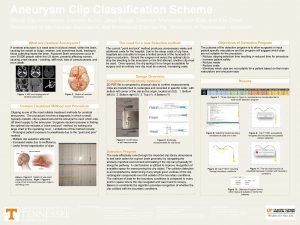Aneurysm Clip Classification Scheme Dandy Clip Innovations Caroline

- Slides: 1

Aneurysm Clip Classification Scheme Dandy Clip Innovations: Caroline Burch, Jared Boggs, Shannon Mc. Adams, Alex Ellis, and Kile Cleer Department of Mechanical, Aerospace, and Biomedical Engineering, University of Tennessee – Knoxville What are Cerebral Aneurysms? The need for a new Selection method: Objectives of Detection Program A cerebral aneurysm is a weak area in a blood vessel, within the brain, causing the vessel to bulge, weaken, and sometimes burst, leading to blood collecting inside the brain. Ruptured Brain aneurysms occur in over 30, 000 people within the US alone, primarily affecting women, causing onset nausea / vomiting, stiff neck, loss of consciousness, and even death. The current “point and pick” method produces unnecessary waste and additional costs for the hospital. Due to the steep costs of clip treys, hospitals are only able to house a limited amount of the hundreds of clips in production. Should the surgeon not select the optimal clip to stop the bleeding to the aneurysm on the first attempt, another clip must be used. Once opened, the clip spring it is no longer acceptable for surgery and an entirely new clip must be ordered, increasing costs. The purpose of the detection program is to allow surgeons in input patient specific vasculature and the program will suggest which clips are not suitable for the procedure. - Reduce clipping selection time resulting in reduced time for procedure - Increase patient safety - Reduce waste - Reduce costs - Eliminate which clips are not suitable for a patient based on their brain vasculature and aneurysm size Design Overview: Results Compilation of Clip library Database Figure 1: MRI and Angiograms of cerebral aneurysms Figure 2: Sketch of cerebral aneurysms 2 D PDF file is compared to physical clips to confirm measurements. Clips are transformed to rectangles and recorded in specific order, with bottom left corner of the clip as the origin, located at (0, 0). 1. Bottom left (X) 2. Bottom right (X) 3. Top (Y) 4. Bottom (Y) Figure 7: Three clips seen in Figure 6, represented as coordinates that is read by the detection program Current Treatment Method and Procedure Clipping is one of the most reliable treatment methods for cerebral aneurysms. The procedure involves a diagnosis in which a small, typically metallic, clip is placed around the aneurysm’s neck which cuts off blood supply to the aneurysm. Surgeons decision process in finding the optimal clip includes a ”point and pick” method, by looking at a large chart in the operating room. Limitations of this method include: - Prolonged patient exposure to anesthesia due to the “point and pick” method - Multiple clip selection attempts - Increased waste due to inefficiency - Lacks formal organization of clips Figure 8: Selecting loaded boundary conditions of case one or two. Figure 5: Confirmation of pdf measurements Figure 9: Clip FT 760 T successfully navigated the boundaries and passed collision detection. Figure 6: Rectangle measurements for clip library Detection Program The code effectively runs through the imported clip library dimensions to test each option for a given brain geometry by navigating the similarly imported environment and testing if the clip can physically fit along the pathway. A cost function is utilized to improve recognition of available space for maneuvering the clip object. The collision detection is accomplished by determining if any single given vertices of the clip rectangular components ever fell outside of the boundary conditions. The matrices of data for the boundary conditions is compared to every point in space where the clip navigated and was found to occupy. Based on constraints the algorithm provides recognition of whether the clip collided with the boundary conditions. Above - Figure 3: Sketch of aneurysm clipping procedure Right – Figure 4: Large Chart of cerebral aneurysm clips in operating room Acknowledgements: Dr. Jeffrey A. Reinbolt, Ph. D. Associate Professor Director of Biomedical Engineering Graduate Studies Mechanical, Aerospace, & Biomedical Engineering The University of Tennessee - Knoxville Dr. Dustin Osborne, Ph. D. , DABSNM, Associate Professor, Radiology Director, Clinical Research Molecular Imaging & Translational Research Program University of Tennessee Graduate School of Medicine Figure 10: Clip FT 833 T traveling through boundary conditions Figure 11: The clip was found to be unsuitable because it collided with boundary conditions. Figure 12: Detection Program shows which clips are suitable or not for the pathway Dr. Michael Walsh Board certified neurosurgeon Clinical Assistant Professor of Surgery Director of Neuro-Oncology at UTMCK

